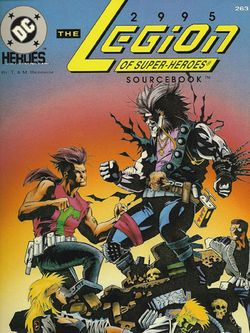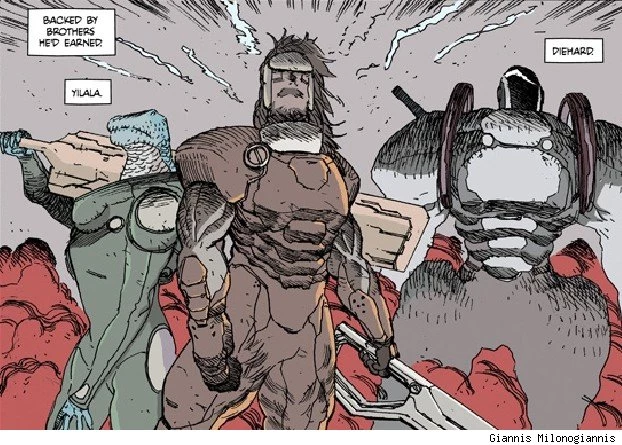4 hours ago
Friday, July 4, 2014
Thursday, July 3, 2014
In the Days of Archaic Oikumene
The Archaic Oikumene controlled the area of the Strange Stars until approximately 31.5 gigaseconds [a millennium in Old Earth reckoning] ago. This fabled age was even stranger than the present:
 |
| Art by Jack Kirby |
An astronate, carrying within its containment suit numerous acquired minds, walks the lesser known hyperspatial paths to find the proper place and time for the transformation of all its minds into single, toposophically transcendent intellect.
 |
| Art by Simon Roy |
A tlekaklek grandee from the rail city on Mercury astride a humandrill bearer (whose troop mind-consensus has chosen to side with the tlekaklek) seeks an audience with the sleeping Gaia oversoul in a temple in the Mediterranean basin of Old Earth. The tlekaklek seeks loans of computronium to support xir people's conflict with the Jovian Unity.
Some principalities sponsored hunts for hyperspace worms, ostensibly because they damaged the exotic matter supports of the hyperspace conduits, but also to harvest their neural fluid (a mild intoxicant that enhances spatial awareness). Hunters scoured the spacing lanes perhaps never guessing--at least never caring--that the beings they hunted were also descendants of paleo-humanity. By the end of age, the worms (then known as hyubh) had grown to gigantic size and had become a true hyperspace shipping menace.
Wednesday, July 2, 2014
Wednesday Comics: The Price
We continue our examination of Jim Starlin's Dreadstar Saga with The Price. The earlier posts in the series can be found here.
Eclipse Graphic Album Series #5 (October 1981) Story & Art by Jim Starlin
Synopsis: The Empirical Galaxy is in the midst of a 200 year-old war between two super-powers: The Monarchy and the Instrumentality. Altarix is a world of the Instrumentality, home to its mystic Order of Vieltoor. It's also the home of Lord High Bishop Darklock and his brother Ajar'l Darklock.
Ajar'l is a tax lawyer, ferreting out those who seek to defraud the Instrumentality. Where his brother is interested in the mystical, Ajar'l is concerned with the practical. All things considered, Ajar'l doesn't get the sort of death he would've expected:
Darklock senses his brothers death and quickly goes to the scene. The police tell him it was a murder committed by fringe religious cultists. Darklock is skeptical that it was a human crime. The police assure him that supernatural involvement was ruled out by one of the cardinals of the Papal Council who has already been there.
Darklock does to the Lord Papal to request a leave of absence:
The Lord Papal know's Ajar'l's death smacks of demonic attack, and he warns Darklock against engaging in unauthorized vengeance.
When he's gone, Cardinal Spyder asks Lord Papal why he granted Darklock leave. He knows he plans to seek vengeance. Lord Papal did so because he senses what Darklock sensed--and more:
Darklock is a powerful and ambitious man. Lord Papal sees this as a chance to get read of a potential rival.
TO BE CONTINUED...
Ajar'l is a tax lawyer, ferreting out those who seek to defraud the Instrumentality. Where his brother is interested in the mystical, Ajar'l is concerned with the practical. All things considered, Ajar'l doesn't get the sort of death he would've expected:
Darklock senses his brothers death and quickly goes to the scene. The police tell him it was a murder committed by fringe religious cultists. Darklock is skeptical that it was a human crime. The police assure him that supernatural involvement was ruled out by one of the cardinals of the Papal Council who has already been there.
Darklock does to the Lord Papal to request a leave of absence:
The Lord Papal know's Ajar'l's death smacks of demonic attack, and he warns Darklock against engaging in unauthorized vengeance.
When he's gone, Cardinal Spyder asks Lord Papal why he granted Darklock leave. He knows he plans to seek vengeance. Lord Papal did so because he senses what Darklock sensed--and more:
Darklock is a powerful and ambitious man. Lord Papal sees this as a chance to get read of a potential rival.
TO BE CONTINUED...
Things to Notice:
This graphic novel is billed as "A new Metamorphosis Odyssey book" thought there isn't anything in its setting or characters to tie it to that other work (yet).
An oppressive church state is a trope Starlin has worked with before. The Church of Universal Truth was the main bad guy of Starlin's "Magus Saga" at Marvel. The use of the term "Instrumentality" may have it's origins in Cordwainer Smith's Instrumentality of Mankind.
- In the Dreadstar-verse, the Earth was destroyed in 1980.
- The original story was in black and white. It was later colorized and reprinted as Dreadstar Annual #1.
This graphic novel is billed as "A new Metamorphosis Odyssey book" thought there isn't anything in its setting or characters to tie it to that other work (yet).
An oppressive church state is a trope Starlin has worked with before. The Church of Universal Truth was the main bad guy of Starlin's "Magus Saga" at Marvel. The use of the term "Instrumentality" may have it's origins in Cordwainer Smith's Instrumentality of Mankind.
Monday, June 30, 2014
The Future of Superheroes
Most superheroes (and superhero rpgs) are set in the modern day. There's no reason superheroes have to be limited to that era, of course. At least as early as 1955, we got a glimpse of Brane Taylor, the Batman of the year 3000. Just a few years later, the preeminent group of future heroes made their debut: The Legion of Super-Heroes. These guys were big enough to get supplements of both editions of the Mayfair DC Heroes rpg: Legion of Super-Heroes vol. I and II and 2995: The Legion of Super-Heroes Sourcebook.
Marvel's answer to the Legion was the Guardians of the Galaxy. These guys were not the super-group of b-list characters about to get a movie; this was a group of freedom fighters against Badoon tyranny in the 31st century. They were (originally) mostly from the Sol System, leaving one to wonder how they were going to guard the whole galaxy. They got a series in the 90s, but then their name was given to another group. No rpg supplement for any Marvel game.
There are a number of future heroes in dystopian futures--enough that I think they are really a separate subgenre. Most of these are at Marvel and the lion's share are alternate timelines from the X-Men. Marvel did have a whole 2099 line that was slightly less dystopian than most X-Men futures.
A more science fictionish approach to the future supers is Image's Prophet. The story isn't particularly superheroic so far so maybe a superhero rpg wouldn't be the best system for it, but it is completely tied to the modern day Extreme comics universe and does feature future versions of Prophet, Diehard, Troll, and Bedrock.
Anyway, there's a lot of inspiration to be had in the above works, I think.
Sunday, June 29, 2014
What's that Aurogov Talking About?
Well, he may be filling that Wanderer avatar in on the fact that the Strange Stars Index has been updated. So, if you missed the posts about the amazon hive of the Sisterhood of Morrgna, some odd artifacts of the Strange Stars, the Radiant Polity, the ngghrya trackers, or the hwuru, you might want to check it out.
You can also find out about Wanderer remote avatars and Aurogov there, too.
Friday, June 27, 2014
Hall of Fame
Thanks to Jay at Exonauts! for pointing this out: Leigh Brackett got inducted into the Science Fiction and Fantasy Hall of Fame this year, along with the Frank Frazetta, Olaf Stapledon, Stanley Kubrick, and Hayao Miyazaki. Stellar company, indeed!
Thursday, June 26, 2014
In the Light
 |
| Art by Nico |
The civil servants of the Polity were it's most common face. Many were volunteers; others were drafted. They administered the noospheric fora (where members could petition the lords) and the Polity controlled hyperspace network, collected tolls, and handed out encryption keys for it's use to members. Through these measures the Polity effectively controlled interstellar trade and exerted soft power to shape planetary governments.
Not all it's power was soft. Polity membership made a sophont or a world subject to the justice of the Radiant Lords--justice meaning anything the lord in question felt would further the needs of the Polity and by extension humanity. They had a strict code and seldom acted rashly, as actions determined to be in error by review of their fellow lords carried harsh penalties, but they wielded great power and acted decisively--even brutally--when necessary. The lords all appeared baseline human, but their nervous systems were linked to their swift sophont ships, their brains modified with psybernetics (1), and their bodies enhanced. Each acted as a combination law enforcer, spy, advisor, and diplomat. When real war was needed, lords' code required they withdraw, and Hannibal Early was summoned.
In an effort to keep the peace, the Polity prohibited the export of irrational memeplexes such as religion between cultures. It was this prohibition that brought it into the conflict with the emerging Instrumentality of Aom and ultimately led to it's dissolution.
(1) It's believed that the psi-research NGO the Phaidros Group was involved with the Polity inception. If so, they abandoned it before it's final fall to begin their colony on Smaragdoz.
Subscribe to:
Posts (Atom)





















